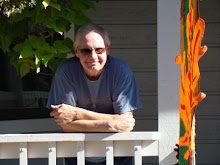What's New? Satellite 2007 in Washington DC
My blistered feet tell the story......."Mr. Scott, the Convention Center is only 7 blocks away", the hotel desk clerk said.....I'm calling that the 4th big lie! The notion of a city block takes on a whole new meaning in D.C.!
Our company was an Exhibitor at the annual trade show dubbed Satellite 2007 this year and although the crowd was certainly not overwhelming in size, it was very high quality. It ran from Tuesday Feb. 20th through Thursday, Feb. 22nd and was directed at those who buy or sell "space segment", as satellite provided bandwidth is often dubbed, and the equipment used to transmit and receive it on the ground and in space.
The folks with exhibits, about 230 strong (organizers claim there were 270), spent a fair amount of time trying to strike deals with each other, as they do every year....and then competed for the attention of several thousand attendees......I'd guess maybe 3,000 or so of them actually toured the floor (organizers claim there were 8000 attendees).
The most talked about subjects on the convention floor included how ka band satellite internet is actually working out, how much of a real threat it will be to ku band offerings down the road and the reality check everyone in the industry did regarding the threat of EV-DO broadband in the U.S. to the satellite internet business. There are many very differing theories about what the landscape for high speed internet will look like in the underserved parts of the U.S. over the next few years, but most experts agree that EV-DO cell cards will play a pretty big part of the growth. The greatest drawback to this technology from my perspective is the high cost of wireless routers to move the high speed internet of EV-DO to multiple computers.....too few router choices and some of them cost over $500 - compared to $50-90 for standard high speed routers. The other obvious shortcoming is the lack of infrastructure in rural areas.......and the unlikely haste that it will be built out any time soon.
The early reports of how well ka band has been doing as a competitor to ku band aren't very encouraging to most I spoke to either. The wealth of "white papers" done on ka bandwidth reuse and lower costs associated with this platform are not showing themselves, at least with the efforts made to this point by Telesat, Wildblue, EchoStar and Intelsat to test or provide ka service. EchoStar has just begun to start using the huge amount of ka space it has on SES Americom satellites AMC 15 & 16. And that is for HDTV for the most part and downstream only. It was interesting to see and meet many of the Pioneers of the Satellite TV and Data era at the convention including one of the Founders of EchoStar and a legend in the industry, Charley Ergen.
Our company was an Exhibitor at the annual trade show dubbed Satellite 2007 this year and although the crowd was certainly not overwhelming in size, it was very high quality. It ran from Tuesday Feb. 20th through Thursday, Feb. 22nd and was directed at those who buy or sell "space segment", as satellite provided bandwidth is often dubbed, and the equipment used to transmit and receive it on the ground and in space.
The folks with exhibits, about 230 strong (organizers claim there were 270), spent a fair amount of time trying to strike deals with each other, as they do every year....and then competed for the attention of several thousand attendees......I'd guess maybe 3,000 or so of them actually toured the floor (organizers claim there were 8000 attendees).
The most talked about subjects on the convention floor included how ka band satellite internet is actually working out, how much of a real threat it will be to ku band offerings down the road and the reality check everyone in the industry did regarding the threat of EV-DO broadband in the U.S. to the satellite internet business. There are many very differing theories about what the landscape for high speed internet will look like in the underserved parts of the U.S. over the next few years, but most experts agree that EV-DO cell cards will play a pretty big part of the growth. The greatest drawback to this technology from my perspective is the high cost of wireless routers to move the high speed internet of EV-DO to multiple computers.....too few router choices and some of them cost over $500 - compared to $50-90 for standard high speed routers. The other obvious shortcoming is the lack of infrastructure in rural areas.......and the unlikely haste that it will be built out any time soon.
The early reports of how well ka band has been doing as a competitor to ku band aren't very encouraging to most I spoke to either. The wealth of "white papers" done on ka bandwidth reuse and lower costs associated with this platform are not showing themselves, at least with the efforts made to this point by Telesat, Wildblue, EchoStar and Intelsat to test or provide ka service. EchoStar has just begun to start using the huge amount of ka space it has on SES Americom satellites AMC 15 & 16. And that is for HDTV for the most part and downstream only. It was interesting to see and meet many of the Pioneers of the Satellite TV and Data era at the convention including one of the Founders of EchoStar and a legend in the industry, Charley Ergen.


<< Home